1. AIX \ AIXL
AIX (singkatan dari Advanced Interactive eXecutive) adalah sebuah versi sistem operasi UNIX yang dikembangkan oleh IBM untuk platform server dan workstation IBM RS/6000. Versi pertama dari AIX dibuat berbasiskan sistem operasi UNIX System V release 2. Sebelum dirilis kepada publik, singkatan AIX sebenarnya adalah Advanced IBM Unix. Versi terbarunya, versi 5L 5.3 mendukung hingga 64 CPU dan mampu mengakses Random access memory (RAM) hingga 2 terabyte. Sistem berkas JFS2 pun mendukung kapasitas partisi dan ukuran berkas maksimum melebihi 16 terabyte.
2. AmigaOS
AmigaOS adalah sistem operasi asli default dari komputer pribadi Amiga. Sistem ini pertama dikembangkan oleh Commodore International, dan awal diperkenalkan pada 1985, yaitu Amiga 1000. Sistem ini berjalan pada seri Motorola 68k dari mikroprosesor 16-bit dan 32-bit, kecuali untuk AmigaOS 4 berjalan pada mikroprosesor PowerPC.
Di puncak kernel preemptive multitasking yakni Exec, ia melibatkan suatu abstraksi perangkat keras unik Amiga, suatu sistem operasi disket yang disebut AmigaDOS, sebuah sistem berjendela API disebut Intuition dan dengan antarmuka pengguna grafis disebut Workbench. Sebuah command line interface disebut AmigaShell juga tersedia dan terintegrasi pada sistem. GUI dan CLI saling melengkapi dan berbagi keistimewaan.
3. BSD
BSD (Berkeley Software Design), Inc., didirikan oleh beberapa pendiri awal developer CSRG sebagai kelanjutan dari pengembangan BSD dalam sisi komersial. BSD/OS telah mendukung untuk banyak platform, seperti i386 dan sparc, yang biasanya dipasarkan dengan memasukkan beberapa applikasi Internet.
Pada tahun 2000, BSDI bergabung dengan Walnut Creek CDROM, sebuah perusahaan yang secara finansial mendukung juga OS FreeBSD . BSD/OS akan dilanjutkan sebagai sebuah produk yang terpisah, namun seperti yang diharapkan, BSD/OS dan FreeBSd Sumber bebas akan digabungkan.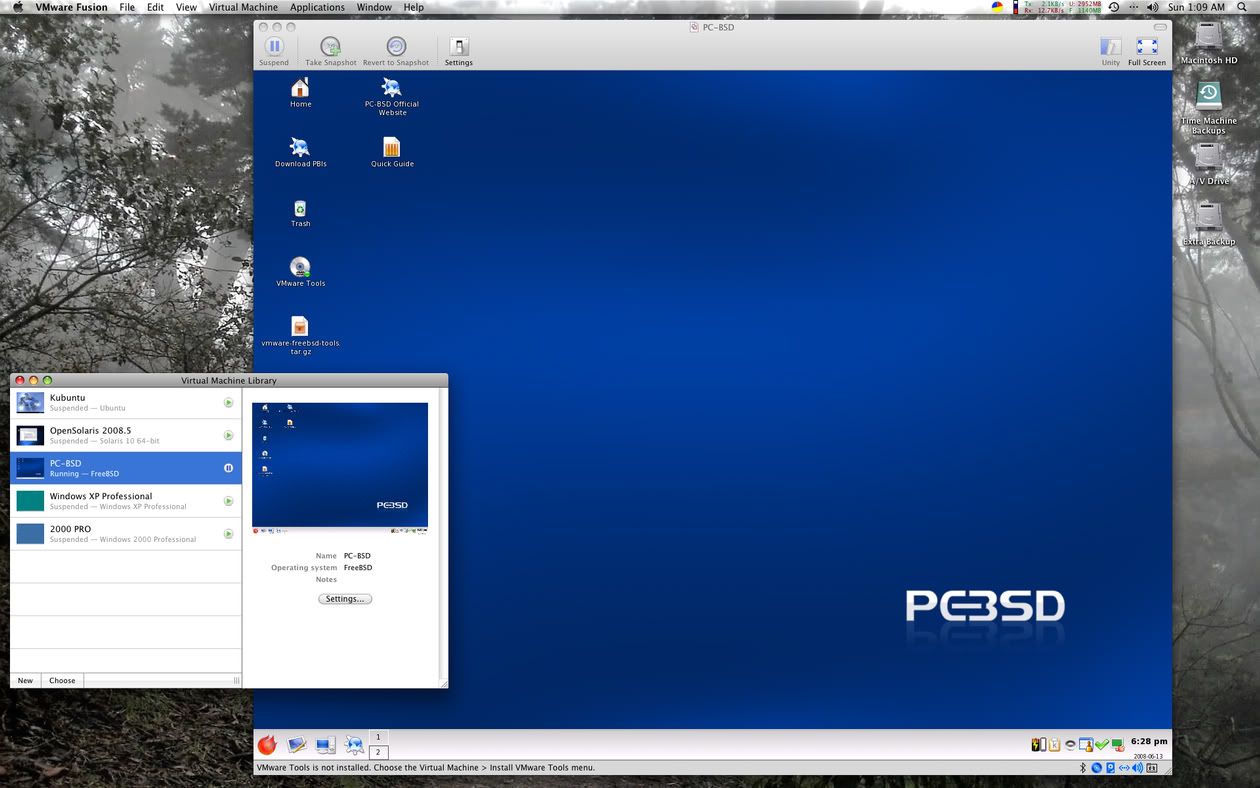
[/spoiler]
4. Minix
Spoiler for
pada awalnya mengembangkan Minix sebagai sebuah sistem operasi UNIX yang kompatibel dengan komputer IBM PC dan IBM PC/AT. Versi 1.5 dari Minix akhirnya di-port ke dalam arsitektur mikroprosesor Motorola 68000, yang digunakan oleh banyak platform populer seperti Atari ST, Amiga, dan Apple Macintosh. Selain x86, dan Motorola 68000, Minix juga dapat berjalan di atas Sun SPARC. Karena Motorola 68000 kurang sukses di pasaran, Minix versi 2.0 akhirnya kembali dibuat hanya dalam format x86 saja. Minix versi 3 telah dirilis, seiring dengan penerbitan buku Operating Systems Design and Implementation, Third Edition (Prentice Hall, 2006, ISBN 0-13-142938-8) yang dibuat oleh Tanenbaum beserta Albert S. Woodhull.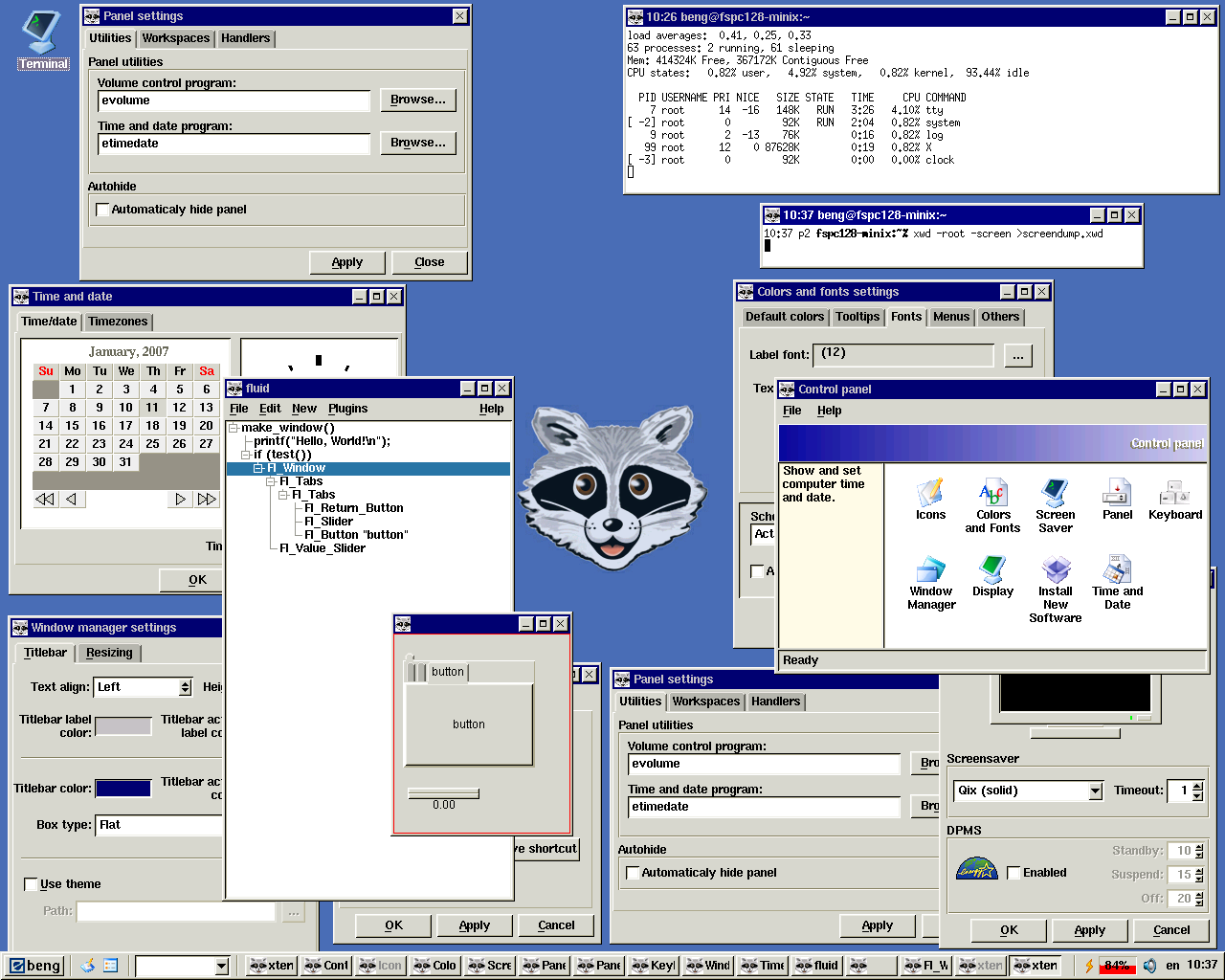
[/spoiler]
5. QNX
Spoiler for
Sebagai OS microkernel berbasis QNX didasarkan pada gagasan sebagian besar menjalankan OS dalam bentuk beberapa tugas yang kecil, yang dikenal sebagai server. Ini berbeda dari kernel monolitik lebih tradisional, di mana sistem operasi adalah program yang sangat besar tunggal terdiri dari sejumlah besar "bagian" dengan kemampuan khusus. Dalam kasus QNX, penggunaan sebuah mikrokernel memungkinkan pengguna (pengembang) untuk menonaktifkan fungsi yang mereka tidak memerlukan tanpa harus mengubah OS itu sendiri, melainkan hanya server yang tidak berjalan.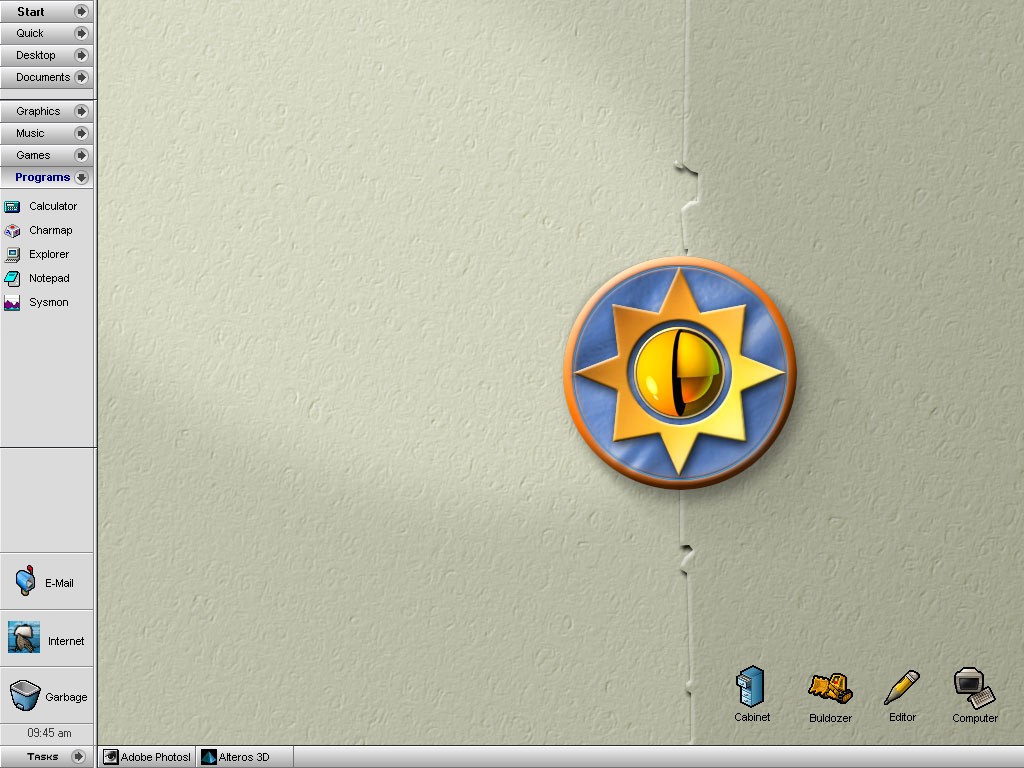
6. SuSe
SUSE , sebelumnya bernama SUSE Linux dan SuSE Linux Professional,[2] , adalah salah satu distro Linux dari perusahaan Novell, atau lebih tepat dari anak perusahaannya Suse Linux GmbH (Software- und System-Entwicklungsgesellschaft mbH, Nürnberg yang berarti pengembangan -perangkat lunak dan -sistem). SUSE Linux awalnya merupakan distro Slackware terjemahan bahasa Jerman. Ada informasi tidak resmi yang mengatakan bahwa S.u.S.E berhubungan dengan ilmuwan komputer Jerman Konrad Zuse karena pengucapan namanya yang sama.
7. Ultrix
The first native VAX UNIX product from DEC was Ultrix-32, based on 4.2BSD with some non-kernel features from System V, and was released in June 1984. Ultrix-32 was primarily the brainchild of Armando Stettner. Its purpose was to provide a DEC-supported native Unix for VAX. It also incorporated several modifications and scripts from Usenet/UUCP experience gained while running decvax. Later, Ultrix-32 incorporated support for DECnet and other proprietary DEC protocols such as LAT. It did not support VAXclustering. Given Western Electric/AT&T Unix licensing, DEC (and others) were restricted to selling binary-only licenses. A significant part of the engineering work was in making the systems relatively flexible and configurable despite their binary-only nature.
[spoiler=Penampakan nya]
8. Xenix
Xenix atau XENIX adalah sistem operasi keturunan UNIX yang dibeli lisensinya oleh Microsoft Corporation dari AT&T sebagai pengembang UNIX Version 7 pada 1979. Setelah itu, Microsoft mengembangkan Xenix sendirian, sebelum akhirnya dibantu oleh Santa Cruz Operation (SCO) yang turut serta mengembangkannya. Xenix merupakan sistem operasi UNIX yang berjalan di atas mikrokomputer 16-bit, di saat sistem UNIX lainnya berfokus pada komputer mainframe. Sistem operasi ini diperkenalkan pada tanggal 25 Agustus 1980, dan menjadi sistem operasi UNIX paling populer pada zamannya.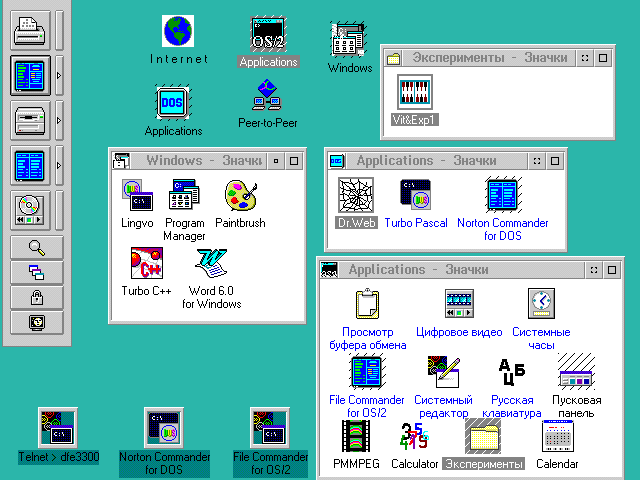
9. Sun Solaris
Sun Solaris adalah sebuah sistem operasi keluarga Unix yang dikembangkan oleh Sun Microsystems Inc. OpenSolaris adalah Sun Solaris yang di open-source kan di bawah lisensi CDDL (Common Development and Distribution License). Sun Solaris bisa dijalankan di atas prosesor yang berspek x86,x64 dan SPARC.
10. Mandrake \ Mandriva
Mandriva Linux (dahulu dikenal dengan nama Mandrakelinux atau Mandrake Linux) adalah sistem operasi yang dibuat oleh Mandriva (dahulu dikenal dengan nama Mandrakesoft). Mandriva Linux menggunakan RPM Package Manager.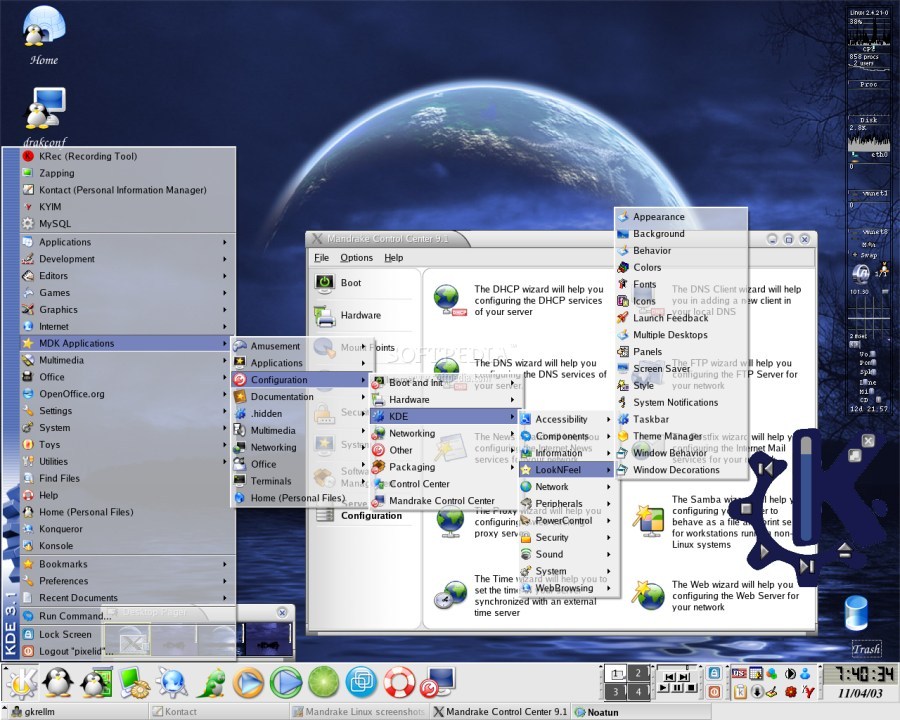
11. ReactOS
ReactOS adalah sebuah proyek perangkat lunak yang bertujuan untuk mengembangkan sebuah sistem operasi yang kompatibel secara biner dengan perangkat lunak aplikasi dan device driver untuk keluarga sistem operasi Microsoft Windows NT 5.x dan yang lebih tinggi (Windows 2000 dan yang setelahnya). ReactOS merupakan salah satu perangkat lunak bebas yang menggunakan proses reverse engineering berupa clean room secara keseluruhan.
12. Windows 1.0
Microsoft Windows 1.0 merupakan versi pertama sistem operasi dalam dunia sistem operasi berbasis Graphical User Interface (GUI) yang dibuat oleh Microsoft Corporation . Versi ini sebenarnya diluncurkan pertama kali pada tanggal 10 November 1983, tapi tidak pernah keluar ke pasar publik sebelum bulan November 1985, karena banyaknya hambatan yang terjadi ketika pengembangan berlangsung.
Windows 1.x bukanlah merupakan sebuah paket sistem operasi GUI—seperti halnya Apple dengan Lisa dan Macintosh-nya, tetapi hanya merupakan paket GUI tambahan yang berjalan di atas DOS, karena itulah, nama kode yang digunakannya adalah Interface Manager. Windows 1.x menggunakan tampilan bitmap (device independent bitmap atau disingkat DIB) dan menambahkan mouse sebagai satu lagi perangkat yang dapat digunakan untuk mengoperasikan Windows.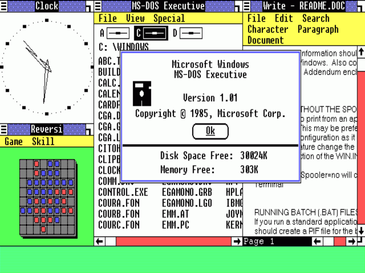
13. Windows NT 3.1
Windows NT 3.1 adalah merupakan produk pertama dari jajaran Sistem Operasi Server Microsoft Windows NT. Produk ini mulai diproduksi tanggal 27 Juli 1993. Tersedia dalam 2 versi, yaitu : Windows NT 3.1 dan Windows NT Advanced Server. Sistem operasi ini kemudian dikembangkan menjadi Windows NT 3.5 pada September 1994.
14. Windows NT 4.0
Microsoft Windows NT 4.0 adalah versi kelanjutan (versi keempat) sistem operasi berbasis kernel NT yang diluncurkan oleh Microsoft Corporation pada 29 Juli 1996. Sistem operasi ini dapat mendukung beberapa platform perangkat keras, mulai dari Intel IA-32 (x86), PowerPC dari IBM, MIPS, dan DEC Alpha dari Digital Equipment Corporation. Sama seperti halnya pendahulunya (Windows NT 3.51), Windows NT 4.0 ini merupakan sistem operasi yang murni 32-bit, yang mendukung beberapa aplikasi DOS, OS/2 modus karakter, Windows 16-bit, Windows 32-bit, serta aplikasi POSIX. Karena merupakan sistem operasi 32-bit, Windows NT 4.0 mendukung hingga 4 gibibyte memori fisik.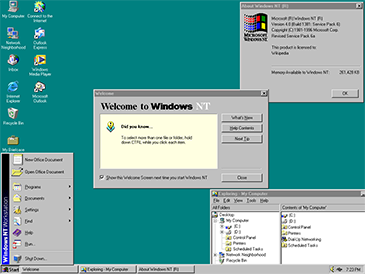
15. Windows 2000
Windows 2000 (atau Windows NT 5.0 build 2159) adalah sebuah versi sistem operasi Windows yang merupakan versi pengembangan dari Windows NT versi 4.0, dikeluarkan oleh Microsoft tanggal 17 Februari 2000 di Amerika Serikat, setelah beberapa kali mengalami penundaan peluncurannya.
16. Knoppix
Knoppix, or KNOPPIX is an operating system based on Debian designed to be run directly from a CD / DVD (Live CD) and a USB key (Live USB), one of the first of its kind for any operating system. Knoppix was developed by Linux consultant Klaus Knopper. When starting a program, it is loaded from the optical disc and decompressed into a RAM drive. The decompression is transparent and on-the-fly.
17. Debian
Debian is a computer operating system composed of software packages released as free and open source software especially under the GNU General Public License and other free software licenses. The primary form, Debian GNU/Linux, which uses the Linux kernel and GNU OS tools, is a popular and influential GNU/Linux distribution. It is distributed with access to repositories containing thousands of software packages ready for installation and use. Debian is known for relatively strict adherence to the Unix and free software philosophies as well as using collaborative software development and testing processes. Debian can be used as a desktop as well as server operating system.
[/spoiler]
18. Ubuntu
Spoiler for
Ubuntu merupakan salah satu distribusi Linux yang berbasiskan Debian. Proyek Ubuntu resmi disponsori oleh Canonical Ltd yang merupakan perusahaan milik seorang kosmonot asal Afrika Selatan Mark Shuttleworth. Nama Ubuntu diambil dari nama sebuah konsep ideologi di Afrika Selatan, "Ubuntu" berasal dari bahasa kuno Afrika, yang berarti "rasa perikemanusian terhadap sesama manusia". Tujuan dari distribusi Linux Ubuntu adalah membawa semangat yang terkandung di dalam Filosofi Ubuntu ke dalam dunia perangkat lunak. Ubuntu adalah sistem operasi lengkap berbasis Linux, tersedia secara bebas dan mempunyai dukungan baik yang berasal dari komunitas maupun tenaga ahli profesional.
19. Mac OS
Mac OS adalah singkatan dari Macintosh Operating System. Mac OS adalah sistem operasi komputer yang dibuat oleh Apple Computer khusus untuk komputer Macintosh dan tidak kompatibel dengan PC berbasis IBM. Diperkenalkan pada tahun 1984, Mac OS sejak tahun 2006 telah memiliki kompatibilitas dengan arsitektur PowerPC maupun x86.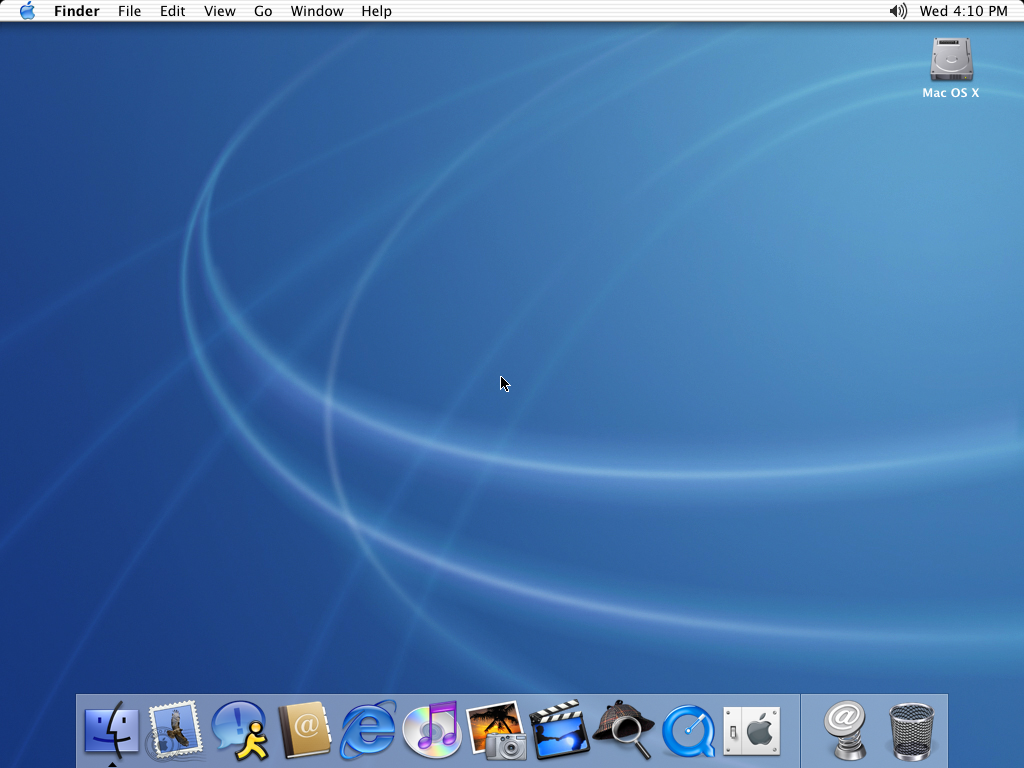
20. Mac OS X
Mac OS X adalah versi terbaru dari sistem operasi Mac OS untuk komputer Macintosh. Sistem operasi ini pertama kali dikeluarkan pada tahun 2001 dan populer di kalangan pengguna.
Karakter "X" adalah nomor Romawi yang berarti sepuluh, di mana versi ini adalah penerus dari sistem operasi yang digunakan sebelumnya seperti Mac OS 8 dan Mac OS 9. Beberapa orang membacanya sebagai huruf "X" yang terdengar seperti "eks". Salah satu alasan mengapa mereka menafsir sedemikian karena tradisi untuk memberikan nama sistem operasi yang berbasis Unix dengan akhiran "x" (misalnya AIX, IRIX, Linux, Minix, Ultrix, Xenix).
21.Rhapsody OS
Rhapsody was the code name given to Apple Computer's next-generation operating system during the period of its development between Apple's purchase of NeXT in late 1996 and the announcement of Mac OS X in 1998. It consisted primarily of the NeXTSTEP operating system ported to the PowerMac along with new graphics in the GUI to make it appear more Mac-like. Several existing Mac OS technologies were also ported to Rhapsody, including QuickTime and AppleSearch. Rhapsody could also run Mac OS 8 in a "Blue Box" emulation layer.
22. Kodiak OS
Apple released to the public, on September 13, 2000, a "preview" version of Mac OS X (internally codenamed Kodiak) in order to gain feedback from users. It cost $29.95 and came with a t-shirt. The "PB" as it was known marked the first public availability of the Aqua interface and Apple made many changes to the UI based on customer feedback. Mac OS X Public Beta expired and ceased to function in Spring 2001.
23. Cheetah OS
On March 24, 2001, Apple released Mac OS X v10.0 (internally codenamed Cheetah). The initial version was slow, incomplete, and had very few applications available at the time of its launch, mostly from independent developers. While many critics suggested that the operating system was not ready for mainstream adoption, they recognized the importance of its initial launch as a base on which to improve. Simply releasing Mac OS X was received by the Macintosh community as a great accomplishment, for attempts to completely overhaul the Mac OS had been underway since 1996, and delayed by countless setbacks. Following some bug fixes, kernel panics became much less frequent.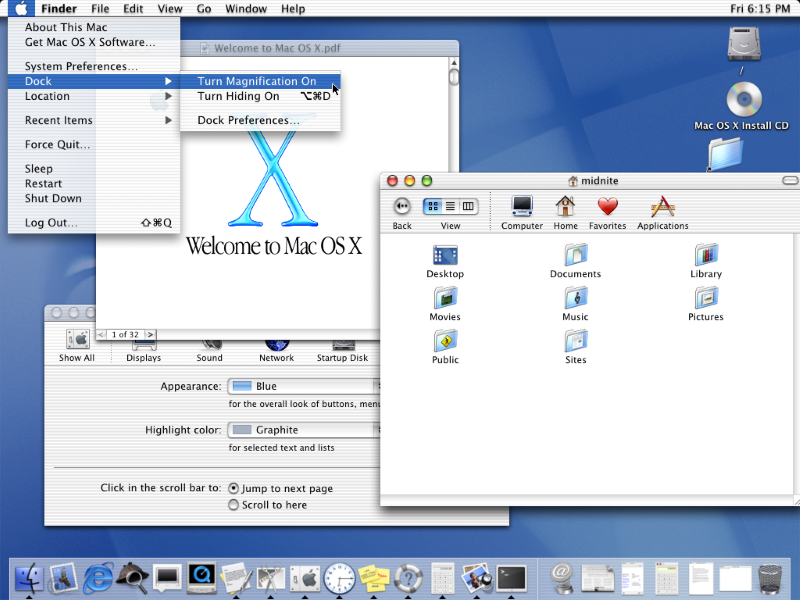
24. Puma OS
Mac OS X version 10.1, code named “Puma”, is the second major release of Mac OS X, Apple’s desktop and server operating system. It superseded Mac OS X v10.0 and preceded Mac OS X v10.2. Version 10.1 was released on September 25, 2001 as a 'free update' to version 10.0. Starting with version 10.1.2, Apple made Mac OS X the default operating system on new Macs.
25. Jaguar OS
Mac OS X version 10.2 “Jaguar” is the third major release of Mac OS X, Apple’s desktop and server operating system. It superseded Mac OS X v10.1 code name Puma and preceded Mac OS X v10.3 “Panther”. The operating system was initially available on 23 August 2002 either for single-computer installations, and in a "family pack",
26. Panther OS
Mac OS X version 10.3 “Panther” is the fourth major release of Mac OS X, Apple’s desktop and server operating system. It followed Mac OS X v10.2 “Jaguar” and preceded Mac OS X v10.4 “Tiger”. Apple released Panther on October 24, 2003.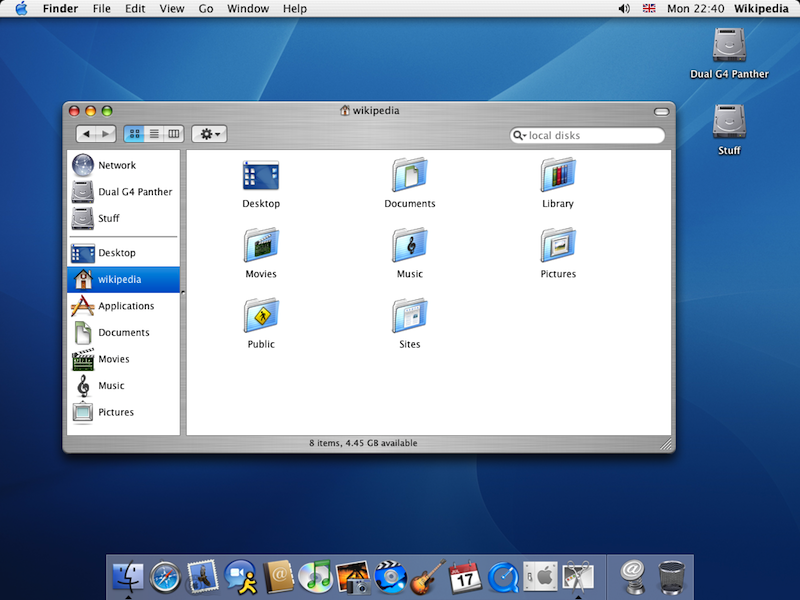
27. Tiger OS
Mac OS X Tiger (version 10.4) is the fifth major release of Mac OS X, Apple’s desktop and server operating system for Macintosh computers. Tiger was released to the public on 29 April 2005 for US$129.95 as the successor to Mac OS X Panther (version 10.3), which had been released 18 months earlier. Tiger was succeeded by Mac OS X Leopard (version 10.5) on 26 October 2007, after 30 months, making Tiger the longest running version of Mac OS X. Some of the new features include a fast searching system called Spotlight, a new version of the Safari web browser, Dashboard, a new ‘Unified’ theme, and improved support for 64-bit addressing on Power Mac G5s.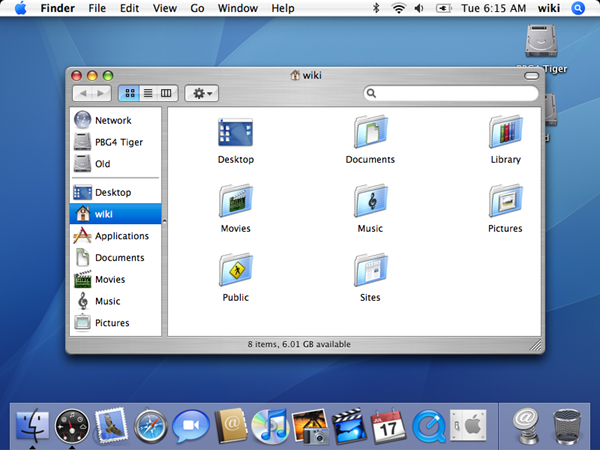
28. Leopard OS
Mac OS X Leopard (version 10.5) is the sixth major release of Mac OS X, Apple’s desktop and server operating system for Macintosh computers. Leopard was released on 26 October 2007 as the successor of Mac OS X Tiger (version 10.4), and is available in two variants: a desktop version suitable for personal computers, and a server version, Mac OS X Server. Steve Jobs stated at Macworld 2008 that over 20% of Macs use Leopard as their operating system. Leopard was superseded by Mac OS X Snow Leopard (version 10.6). Leopard is the final version of Mac OS X to support the PowerPC architecture as Snow Leopard solely functions on Intel based Macs. With the release of Snow Leopard, Leopard will only be maintained with security updates until the next shipping version of Mac OS X.
29. Snow Leopard OS
Mac OS X Snow Leopard (version 10.6) is the seventh and current major release of Mac OS X, Apple's desktop and server certified Unix operating system.
This version of Mac OS X focuses on improving performance, efficiency and reducing its overall memory footprint compared with its predecessor Mac OS X v10.5 "Leopard", rather than new end-user features. This is also the first Mac OS release since the introduction of System 7.1.2 that does not support the PowerPC architecture, as Apple now intends to focus on its current line of Intel-based products.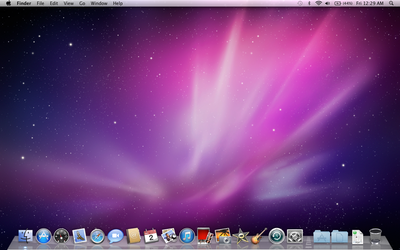
30. Sabertooth OS (Rumor)
I heard from a friend of a friend who is a trusted source of a friend at Apple that 10.7 (codename Sabertooth) will be entirely cloud-based. Basically every device (desktops, Mac netbooks, iPhones, iPods, laptops, and other devices) will not have an OS. Once you turn them on, they will connect to the cloud and download the kernel. After that, a user can edit movies, music, photos, and spreadsheets and pretty much everything else from the big cloud. It will amazing.
Macam-macam Operating System di dunia
Posted by
DGalz PHL
Tuesday, April 26, 2011
Subscribe to:
Post Comments (Atom)



0 comments:
Post a Comment
Silakan mengomentari blog galang